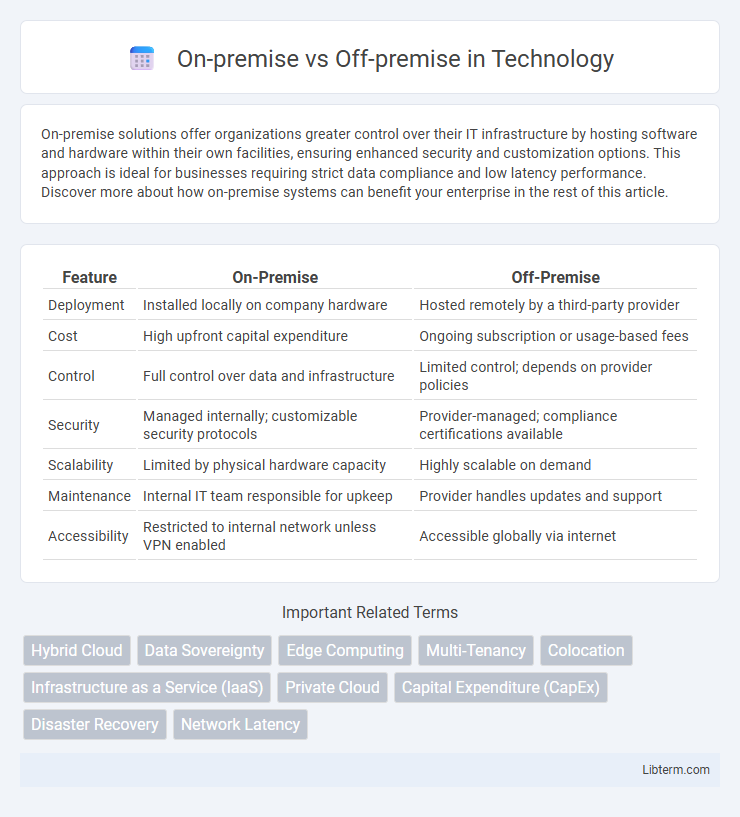On-premise solutions offer organizations greater control over their IT infrastructure by hosting software and hardware within their own facilities, ensuring enhanced security and customization options. This approach is ideal for businesses requiring strict data compliance and low latency performance. Discover more about how on-premise systems can benefit your enterprise in the rest of this article.
Table of Comparison
| Feature | On-Premise | Off-Premise |
|---|---|---|
| Deployment | Installed locally on company hardware | Hosted remotely by a third-party provider |
| Cost | High upfront capital expenditure | Ongoing subscription or usage-based fees |
| Control | Full control over data and infrastructure | Limited control; depends on provider policies |
| Security | Managed internally; customizable security protocols | Provider-managed; compliance certifications available |
| Scalability | Limited by physical hardware capacity | Highly scalable on demand |
| Maintenance | Internal IT team responsible for upkeep | Provider handles updates and support |
| Accessibility | Restricted to internal network unless VPN enabled | Accessible globally via internet |
Introduction to On-Premise and Off-Premise Solutions
On-premise solutions involve hosting software and infrastructure within a company's own data centers, providing full control over security, customization, and compliance. Off-premise solutions, often cloud-based, are managed by third-party providers, offering scalable resources and reduced upfront costs with remote accessibility. Choosing between on-premise and off-premise depends on business needs for control, flexibility, and budget constraints.
Key Definitions: On-Premise vs Off-Premise
On-premise refers to software or hardware systems installed and operated within a company's physical location, maintaining full control and direct management over data and infrastructure. Off-premise, often synonymous with cloud or hosted solutions, involves using external service providers to host and manage resources remotely, offering scalability and reduced maintenance responsibilities. Choosing between on-premise and off-premise solutions depends on factors such as security requirements, cost considerations, and compliance regulations.
Infrastructure and Deployment Differences
On-premise infrastructure requires organizations to invest in and maintain hardware within their own facilities, ensuring direct control over deployment, security, and customization. Off-premise solutions leverage cloud providers' data centers, offering scalable and flexible deployment without the need for physical hardware management. This fundamental difference impacts cost structures, control levels, and the agility of software updates and resource allocation.
Cost Comparison: Upfront and Ongoing Expenses
On-premise solutions require significant upfront investment in hardware, infrastructure, and IT staff, leading to higher initial costs compared to off-premise options. Off-premise services, often cloud-based, reduce upfront expenses by offering subscription-based pricing, shifting costs to predictable ongoing operational expenses. Over time, ongoing maintenance, upgrades, and personnel expenses associated with on-premise deployments typically result in higher total cost of ownership compared to scalable, vendor-managed off-premise alternatives.
Security Considerations and Compliance
On-premise deployments offer organizations direct control over security protocols, physical access, and data governance, enabling tailored compliance with industry-specific regulations such as HIPAA, GDPR, or PCI DSS. Off-premise, cloud-based solutions provide scalable security features managed by third-party providers, but require rigorous due diligence to ensure adherence to compliance standards and data sovereignty policies. Evaluating data encryption, access controls, audit logs, and service-level agreements is critical to balancing risk and regulatory requirements between on-premise and off-premise infrastructures.
Scalability and Flexibility
On-premise solutions offer limited scalability due to fixed hardware capacity and require significant upfront investment to expand, restricting flexibility in adapting to changing business demands. Off-premise cloud services provide dynamic scalability, allowing businesses to easily adjust resources based on real-time needs and pay-as-you-go models, enhancing operational flexibility. This elasticity supports rapid growth and fluctuating workloads without the need for physical infrastructure changes.
Maintenance, Upgrades, and Support
On-premise solutions require in-house IT teams to handle maintenance, upgrades, and support, often leading to higher operational costs and longer downtime during updates. Off-premise or cloud-based services provide vendor-managed maintenance and automatic upgrades, ensuring minimal disruption and access to the latest features without additional staffing. Support for off-premise systems typically includes 24/7 vendor assistance, whereas on-premise support depends largely on internal resources or contracted third-party providers.
Use Cases: When to Choose On-Premise or Off-Premise
On-premise solutions are ideal for organizations requiring stringent data security, compliance with industry regulations, and full control over hardware and software environments, such as financial institutions and healthcare providers. Off-premise options excel in scalability, cost efficiency, and ease of access, making them suitable for startups, remote teams, and businesses with fluctuating workloads or limited IT resources. Companies facing unpredictable growth or needing rapid deployment often benefit from hybrid approaches combining on-premise control with off-premise flexibility.
Performance and Reliability Factors
On-premise solutions typically offer higher performance due to direct control over hardware resources and reduced latency, enabling faster data processing and response times. Reliability in on-premise setups depends heavily on in-house IT maintenance and infrastructure quality, which can vary widely across organizations. Off-premise, or cloud-based services, deliver scalability and redundancy through distributed data centers, often ensuring superior uptime and disaster recovery despite potential latency issues caused by internet dependence.
Future Trends in IT Infrastructure Choices
Future trends in IT infrastructure indicate a growing hybrid approach, where businesses increasingly integrate on-premise systems with off-premise cloud solutions to maximize flexibility, scalability, and security. Advances in edge computing and AI-driven resource management are enhancing the efficiency of on-premise deployments, while multi-cloud strategies and serverless computing continue to expand off-premise capabilities. As cybersecurity threats evolve, organizations are prioritizing zero-trust architectures and data sovereignty, influencing the balance between on-premise control and off-premise agility in infrastructure decisions.
On-premise Infographic

 libterm.com
libterm.com